Reynoldston, New York, is still a place on a map, but little remains from the period during which this community thrived on local forest resources – a short fifty years, 1880-1930 (see Timeline). While the story of the community is not unique to so many single resources town, what is unique is that the large amount of material, oral history, historical photographs, original documents provide us with clear picture of the mill business as well as day to day life in the community. By 1930’s, the state had acquired most of the Reynolds Bros Mill properties and most of the mill buildings, except for some of the original company houses, had disappeared. Some of these homes persisted into the 1970’s, but today only a very few remain.
Mill Town
Reynoldston was built on an extractive industry: milling and logging. It was a late expression of the Industrial Revolution, consisting essentially of two industries: a logging operation that employed work crews housed in spartan barracks, and a mill where the raw logs felled by those crews were processed, often by some of the same workers.
Just as the inhabitants of 19th century factory towns in New England and in central New York often depended on one mill owning family for work, housing, and supplies, so most of the citizens of Reynoldston depended on the Reynolds mill and logging operations for much of their existence. Factory towns disappeared when their products were no longer needed or could be produced more cheaply elsewhere. Reynoldston disappeared when there were no more logs to cut and families moved away for new employment options.
Location of Reynoldston – click on map to increase size
Reynoldston sits about fourteen hundred feet above the St. Lawrence River, in the Town of Brandon, in the north-western corner of Franklin County in New York State’s North Country. This area lies in the foothills of the Adirondack Mountains and provided early residents with forests rich in both hardwoods and softwoods: maple, elm, birch, pine, and spruce. Although the earliest residents attempted to farm, the rocky land was never suitable for most agriculture and it was the forest industry that allowed the community to develop. The Deer River flows through Reynoldston, and made possible the development of water driven sawmills. Click on the 1876 map on the right of Brandon and the names of the earliest settlers as well the location of the Reynolds Mill and the Wesbster Mill.
Early Settlers – 1870’s
Just after the Civil War, Adirondack hardwood trees were already in demand for making black salts (potash) or to supply potash for tanneries in the area and in Montreal. For most of the early residents of northern Franklin County potash was one of the few ways to earn hard cash. Thus early settlers in Reynoldston, surrounded by forest, hauled potash to Fort Covington, on the Canadian border, where they received much needed cash. (see Making Potash)
Early Mill – Webster Mill – 1870’s
Brandon’s forests also fed several small lumber mills in the 1870s and ‘80s. Best known was the Webster Mill, on the Deer River just above where the Reynolds Mill would be built. Some of the earliest settlers, who attempted to farm in what would become Reynoldston, worked in the Webster Mill until it ceased operation in 1873, just about the time that Orson Reynolds began his own mill and logging operations in what would become Reynoldston.
Reynolds Bros. Mill – 1870’s
 Reynoldston, originally called Reynolds Mill, was never incorporated. It took its name from the Reynolds’ Brothers Lumber Mill & Co., located just off the Eddy Roadand on the banks of the Deer River. The settlement grew from the Reynolds family’s eagerness to profit from the area’s expansive forests, and died when the Company had cut the last tree. As the last stands of timber fell, so, too, did the livelihood of most Reynoldston residents. Today, almost a century after the closing of the Reynolds Mill, the forests have reclaimed their prominence along the banks of the Deer River.
Reynoldston, originally called Reynolds Mill, was never incorporated. It took its name from the Reynolds’ Brothers Lumber Mill & Co., located just off the Eddy Roadand on the banks of the Deer River. The settlement grew from the Reynolds family’s eagerness to profit from the area’s expansive forests, and died when the Company had cut the last tree. As the last stands of timber fell, so, too, did the livelihood of most Reynoldston residents. Today, almost a century after the closing of the Reynolds Mill, the forests have reclaimed their prominence along the banks of the Deer River.
Mill Towns in America
The history of Reynoldston is not unique. All across America stories can be told about small sawmill towns’ rise and fall as the local forest wealth was cut, to be followed by the decline of the communities that once depended upon these forests for their survival.
Forest Conservation Movement
In the late 1800’s, at the time that logging was accelerating in the Adirondacks, there was a heightened interest in forest conservation in New York State. Cornell University tried to start a school of forestry, pamphlets on reforestation appeared and more and more people understood the value of conserving the wilderness. In 1892 the New York State legislature created the Adirondack and Catskill State Parks. The clear cutting practices of the Reynolds firm and similar operations stand in stark contrast to these conservation efforts.
After the Civil War – 1865
It was only after the Civil War that individuals discovered that land at the end of Eddy Road held any promise of making a living for their families. The earliest settlers were from different backgrounds, but soon their lives and even their families would become intertwined. Initially it was the potential for farming, limited though it was, that attracted the first settlers.
Search for Land – 1870’s
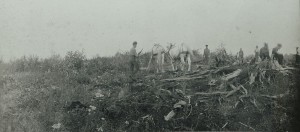 Few realize that through the 19th century settlers from Vermont and New England as well as from Quebec moved into Northern New York in search of work and farming, essentially creating an Eastern frontier. This particular mix of family backgrounds that resulted from this migration was the norm for the entire North Country area. The first settler in what was to become Reynoldston may have been Allen Bordeaux, who arrived about 1869.
Few realize that through the 19th century settlers from Vermont and New England as well as from Quebec moved into Northern New York in search of work and farming, essentially creating an Eastern frontier. This particular mix of family backgrounds that resulted from this migration was the norm for the entire North Country area. The first settler in what was to become Reynoldston may have been Allen Bordeaux, who arrived about 1869.
Early Families Arrive – 1870’s
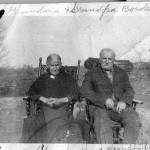 Shortly after Allen & Julia Bordeaux’s (pictured on the right) arrival on the Eddy Road both Orson L. Reynolds and Joseph Campbell moved nearby. Whereas Allen had been born in Quebec, had likely trained for the priesthood, and spoke mostly French, Orson Reynolds was a Yankee, who had been a town justice in Bombay, and had fought in the Union Army. Similarly Joseph Campbell was fromVermont and also served in the Union Army. Now they all were looking forsomething more.
Shortly after Allen & Julia Bordeaux’s (pictured on the right) arrival on the Eddy Road both Orson L. Reynolds and Joseph Campbell moved nearby. Whereas Allen had been born in Quebec, had likely trained for the priesthood, and spoke mostly French, Orson Reynolds was a Yankee, who had been a town justice in Bombay, and had fought in the Union Army. Similarly Joseph Campbell was fromVermont and also served in the Union Army. Now they all were looking forsomething more.
Orson L. Reynolds
 Unlike the other settlers who moved to the Eddy Road, Orson Reynolds and his sons acquired extensive forest holdings that at one time totalled more than ten thousand acres. (see Historical Maps) Orson started a logging and milling operation, and the settlement where he and Allen and Joseph and a few others lived soon grew in population and became known as Reynolds’ Mill. The name was formally changed to Reynoldston in 1894 when the community acquired a post office at the Reynolds’ Mill store.
Unlike the other settlers who moved to the Eddy Road, Orson Reynolds and his sons acquired extensive forest holdings that at one time totalled more than ten thousand acres. (see Historical Maps) Orson started a logging and milling operation, and the settlement where he and Allen and Joseph and a few others lived soon grew in population and became known as Reynolds’ Mill. The name was formally changed to Reynoldston in 1894 when the community acquired a post office at the Reynolds’ Mill store.
Reynolds Mill Operations -1870’s
The Reynolds family and mill and logging operations dominated the community physically providing employment for up to a hundred and fifty men at one time. The mill and logging operations were extensive and up to four logging camps – with up to 120 workers – operated at one time during the peak of the hardwood and softwood log cutting. (see Logging and Logging Camps) During this time the Reynoldses diversified their business interests and soon created what can best be described as a prosperous family enterprise. The business included a telegraph and telephone line, a company store, and other mill and business interests. (see Reynolds Mill)
Reynolds Mill issues own paper currency- 1880’s 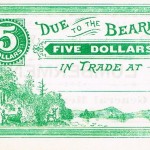
In addition, during the late 1880’s, for a number of years the Reynolds probably short of hard currency issued their own scrip money, or shinplasters for payment of the mill workers and loggers. This currency could only be used to buy goods in the “company store”. Many of the workers resented this in that it limited their options and tied them even closer to the Reynolds business.
Community and Families
 For the next 50 years the lives of the Reynoldses, the Bordeauxs, the Campbells, the Moquins, and the others who moved to the area for work in the mill and woods would be closely entwined. The roughly 60 large exntended families that made Reynoldston their home, not only shared a way of life, but more often then not intermarried with each other or nearby relatives. Over time most families became related through marriage. Click here for more information about the community
For the next 50 years the lives of the Reynoldses, the Bordeauxs, the Campbells, the Moquins, and the others who moved to the area for work in the mill and woods would be closely entwined. The roughly 60 large exntended families that made Reynoldston their home, not only shared a way of life, but more often then not intermarried with each other or nearby relatives. Over time most families became related through marriage. Click here for more information about the community
Reynoldston Populaltion Peaks -1910
Reynoldston, at its peak in 1910-20, had at most three hundred and fifty people, all living on or near the Eddy Road. Over sixty houses lined a mile and a half long stretch of the road. The scene was memorable for its bleakness, and for a monotonous pace of life echoed in the drabness of most of the homes’ and buildings’ unpainted exteriors. From historical photos it is clear hardly a tree was left standing on either side of the Eddy Road – as this photo shows. ooking south towards the Mill Road from the big rock by the schoolhouse ca. 1900, Reynoldston New York.
Community Life
The majority of the Reynoldston townsfolk practiced Catholicism, (see Religion) another bond that shaped this inward-looking community and provided diversion from its arduous existence. Mass was said regularly in one of the resident’s houses by a priest who visited from Bangor. There never was a church in the community.
Farming
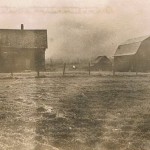 Throughout this period some Reynoldston people attempted to augment their incomes by farming – raising hops, cows and even horses. The extreme cold and long winters provided a very short and limited summer for agriculture. As well, the abundant hardwood forests contained a number of sugar bushes, a source of maple syrup. (see Farming)
Throughout this period some Reynoldston people attempted to augment their incomes by farming – raising hops, cows and even horses. The extreme cold and long winters provided a very short and limited summer for agriculture. As well, the abundant hardwood forests contained a number of sugar bushes, a source of maple syrup. (see Farming)
Isolated Way of Life
Until after World War I and the advent of the automobile, Reynoldston was both physically and socially isolated from the farming towns to the north in the St. Lawrence River Valley. Reynoldston Families needed to be resourceful, and content with what they had, especially to survive the long, cold, and snowy winters. For most families, life was hard and often at a subsistence level.
Dancing Drinking and Fighting
It was a time when men worked hard and women toiled even harder to maintain a home and feed and clothe their very large families. Men could take refuge from the drudgery of labor in boisterous festivities, fuelled by heavy drinking and the wild times at the Bordeaux Dance Hall.
Unique Way of Life
While most people in Reynoldston were moral and law abiding, others saw in the isolation an opportunity to ignore traditional mores and laws. The stories of these tough and independent woodsmen is central to the history of Reynoldston itself. (see Social History) What makes Reynoldston “special” today is the amount of documentation available on this small forest community, and its lively, freewheeling lifestyle (see Bordeaux Dance Hall)- which many would associate with the western American frontier.
Brooklyn Cooperage Contract – 1908
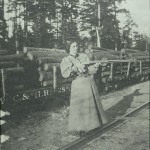 The most intensive logging in Reynoldston and southern Brandon occurred under the large contract that the Reynolds Bros. signed with the Brooklyn Cooperage Company, 1908-1918. A logging railroad spur was built into the area to transport the logs to the Cooperage mill in St. Regis Falls. During this time the sawmill in Reynoldston itself only operated part time, but the Reynolds Bros. logging camps expanded to a total of four. At the end of the contract most of the hardwood forerests in the area around Reynoldston and on the ten thoussand acres the Reynolds owned had been cut for staves.
The most intensive logging in Reynoldston and southern Brandon occurred under the large contract that the Reynolds Bros. signed with the Brooklyn Cooperage Company, 1908-1918. A logging railroad spur was built into the area to transport the logs to the Cooperage mill in St. Regis Falls. During this time the sawmill in Reynoldston itself only operated part time, but the Reynolds Bros. logging camps expanded to a total of four. At the end of the contract most of the hardwood forerests in the area around Reynoldston and on the ten thoussand acres the Reynolds owned had been cut for staves.
Harvesting Pulp -1918
Following the cutting of all the hardwood, most of the softwood was then cut for the Malone Paper Company. During this period it was common to see endless teams of horses drawing loads of log to Malone and returning in the same day.
Closing of the Mill – 1921
By the early 1920’s the Reynolds began the process of closing down their operations in Reynoldston as noted in the: Adirondack News Jan. 16, 1921
“Reynolds Bros. & Co. are arranging to close out their store of general merchandise at Reynoldston and will discontinue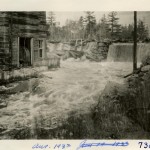 that portion of their business after operating it continuously for over 30 years. Fred H. Orcutt, of Dickinson Center, has been engaged as the firm’s general manager at Reynoldston and has already moved there. He will have charge of saw mill and other wood working department. He has always been familiar with that kind of work”
that portion of their business after operating it continuously for over 30 years. Fred H. Orcutt, of Dickinson Center, has been engaged as the firm’s general manager at Reynoldston and has already moved there. He will have charge of saw mill and other wood working department. He has always been familiar with that kind of work”
Then, in 1925, the mill stopped operating and Reynoldston began its decline. There followed a rapid exodus of families in search of work elsewhere in Northern New York. During the 1930’s the Reynolds family sold off much of their holdings to the state and let other parcels go for taxes. (see Sale of Reynolds Lands)
Civilian Conservation Corp – 1930’s
During the Great Depression, after the State of New York purchased most of the logged forestry lands of the Reynolds, the Civilian Conservation Corp was given the task of building a dirt road in Reynoldston for fire protection. The CC road still exists and in the 1960’s after another bridge was built, now links Skerry with this CC Road.
One Room School Closes – 1940’s
During the 1920’s and ’30’s the few remaining families were raising the last generation of children that would be born in Reynoldston. By the Second World War the one-room school had closed and only a few of the remaining families had children living at home. By the 1960’s and 1970’s, a handful of elderly couples, mostly from the original settler families, were left behind, choosing to live out their old age in the quiet and relative comfort of a place that held mostly memories. Other families kept their homes as summer camps. Today only a few of the original families have any formal connection to “Reynoldston” and only a few of the original homes still exist.


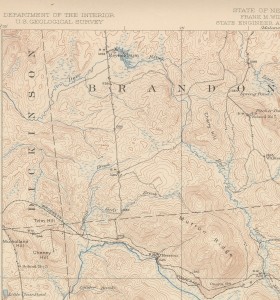
One response to “History of Reynoldston”
[…] History […]